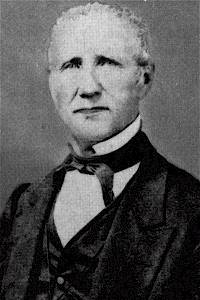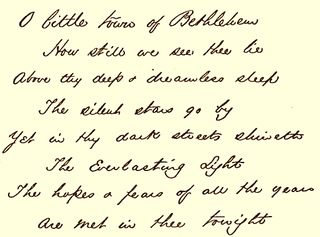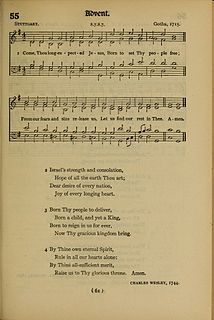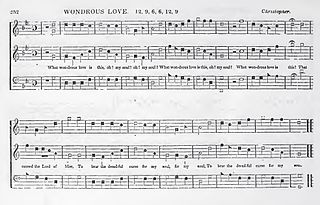
Shape notes are a music notation designed to facilitate congregational and community singing. The notation, introduced in late 18th century England, became a popular teaching device in American singing schools. Shapes were added to the note heads in written music to help singers find pitches within major and minor scales without the use of more complex information found in key signatures on the staff.

"A Mighty Fortress Is Our God" is one of the best known hymns by the reformer Martin Luther, a prolific hymnodist. Luther wrote the words and composed the melody sometime between 1527 and 1529. It has been translated into English at least seventy times and also into many other languages. The words are a paraphrase of Psalm 46.

William Walker was an American Baptist song leader, shape note "singing master", and compiler of four shape note tunebooks, most notable of which was The Southern Harmony.
"The Spirit of God Like a Fire Is Burning" is a hymn of the Latter Day Saint movement. It was written by W. W. Phelps, one of the most prolific hymnwriters of early Mormonism.

"Christ the Lord Is Risen Today" is a Christian hymn associated with Easter. Most of the stanzas were written by Charles Wesley, and the hymn appeared under the title "Hymn for Easter Day" in Hymns and Sacred Poems by Charles and John Wesley in 1739. The hymn eventually became well known for its repetitive "Alleluias" sung after each line, which were added by an unknown author to fit the commonly used hymn tune of "Easter Day". It remains a traditional processional hymn on Easter Sunday.

"How Can I Keep From Singing?" is a Christian hymn with music written by American Baptist minister Robert Wadsworth Lowry. The song is frequently, though erroneously, cited as a traditional Quaker or Shaker hymn. The original composition has now entered into the public domain, and appears in several hymnals and song collections, both in its original form and with a revised text. Though it is not, in fact, a Quaker hymn, twentieth-century Quakers adopted it as their own and use it widely today.

"O Little Town of Bethlehem" is a popular Christmas carol.
"Angel Band" is an American gospel music song. The lyrics – a poem written in common metre – were originally titled "My Latest Sun Is Sinking Fast," and were written by Jefferson Hascall. The lyric was first set in J. W. Dadmun's tunebook The Melodeon in 1860, to a tune by Dadmun. These words, being in common metre, could be sung to many hymn tunes, but the tune now universally associated them is by William Batchelder Bradbury, and was published in Bradbury's Golden Shower of S.S. Melodies in 1862. Bradbury's song was originally titled "The Land of Beulah." "Angel Band" became widely known in the 19th century, both in folk traditions and in published form, e.g. William Walker's Christian Harmony of 1866, and has been recorded by many artists, probably most famously by the Stanley Brothers, Emmylou Harris, and by the Monkees. The Stanley Brothers version is included on the O Brother, Where Art Thou? soundtrack album (2000).

"Es ist ein Ros entsprungen", is a Christmas carol and Marian Hymn of German origin. It is most commonly translated in English as "Lo, how a rose e'er blooming", and is sometimes known as "A Spotless Rose". The rose in the text is a symbolic reference to the Virgin Mary, and the hymn makes reference to the Old Testament prophecies of Isaiah which in Christian interpretation foretell the Incarnation of Christ, and to the Tree of Jesse, a traditional symbol of the lineage of Jesus. Because of its prophetic theme, the song is popular during the Christian season of Advent.
"For the Beauty of the Earth" is a Christian hymn by Folliott S. Pierpoint (1835-1917).

Charles Davis Tillman —also known as Charlie D. Tillman, Charles Tillman, Charlie Tillman, and C. D. Tillman—was a popularizer of the gospel song. He had a knack for adopting material from eclectic sources and flowing it into the mix now known as southern gospel, becoming one of the formative influences on that genre.
The gospel song, Palms of Victory, also called “Deliverance Will Come,” and “The Way-worn Traveler,” was evidently written in 1836 by the Rev. John B. Matthias, a Methodist Episcopal minister in New York state. This attribution is not well documented, and Matthias had no known history of song-writing, but there is no other author to whom it can be attributed.

"Come, Thou Long Expected Jesus" is a 1744 Advent and Christmas carol common in Protestant hymnals. The text was written by Charles Wesley. It is performed to one of several tunes, including "Stuttgart" and "Hyfrydol". It is hymn number 66 in the Episcopal Church hymnal ; hymn number 196 in the United Methodist Hymnal ; hymns 1 and 2 in the 1990 Presbyterian Hymnal; and hymn 254 in Evangelical Lutheran Worship, among others. The hymn is considered an enduring classic in Christian hymnology.

"What Wondrous Love Is This" is a Christian folk hymn, sometimes described as a "white spiritual", from the American South. Its text was first published in 1811, during the Second Great Awakening, and its melody derived from a popular English ballad. Today it is a widely known hymn included in hymnals of many Christian denominations.

"The Babe in Bethlem's Manger", also called "The Babe in Bethlehem's Manger Laid", "Old Kentish Carol" and "The Saviour's Work", is an anonymous English folk Christmas carol celebrating the birth of Jesus in Bethlehem.












